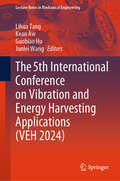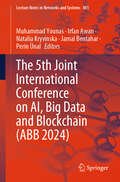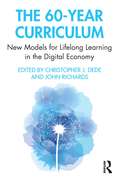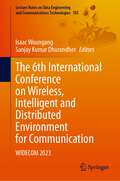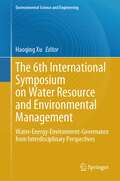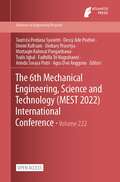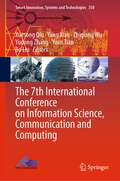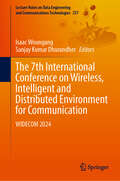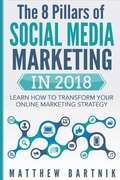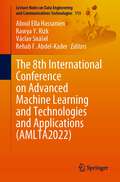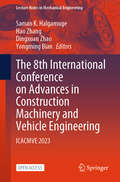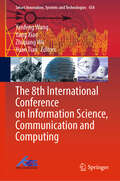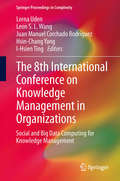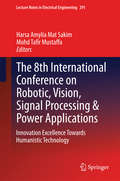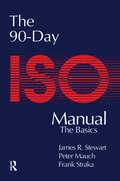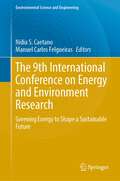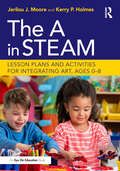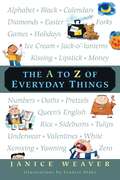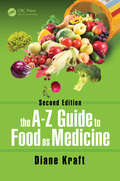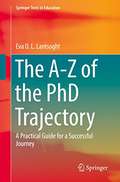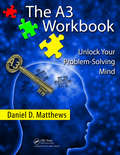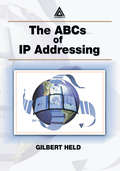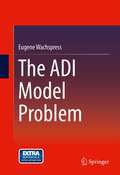- Table View
- List View
The 5th International Conference on Vibration and Energy Harvesting Applications (Lecture Notes in Mechanical Engineering)
by Lihua Tang Kean Aw Guobiao Hu Junlei WangThis book presents select proceedings of the 5th International Conference on Vibration and Energy Harvesting Applications (VEH 2024). This book covers latest research and technological advances in the field of vibration analysis, energy harvesting, and its applications. Topics covered in the book include innovative research works related to vibration analysis, energy harvesting, their applications, and results on the mechanical design, optimization, dynamics, power management circuits and systems, MEMS technology, nanotechnology, new materials, self-powered IoT applications, and other related areas.. The book can be a valuable reference for researchers and professionals interested in vibration analysis, energy harvesting, its applications, and allied fields.
The 5th Joint International Conference on AI, Big Data and Blockchain (Lecture Notes in Networks and Systems #881)
by Muhammad Younas Irfan Awan Natalia Kryvinska Perin Ünal Jamal BentaharThis book is the 5th Joint International Conference on AI, Big Data and Blockchain (ABB 2024), 19–21 Aug 2024, Vienna, Austria. This book constitutes refereed articles which present research work on timely research themes such as novel AI methods and models, deep learning techniques, data analytics and hidden patterns, security, privacy and trust, blockchain data management, and fraud detection and prevention, among others. The intended readership of the book includes researchers, developers, and practitioners in the areas of AI, big data, blockchain techniques, technologies, and their applications.
The 60-Year Curriculum: New Models for Lifelong Learning in the Digital Economy
by Christopher J. DedeThe 60-Year Curriculum explores models and strategies for lifelong learning in an era of profound economic disruption and reinvention. Over the next half-century, globalization, regional threats to sustainability, climate change, and technologies such as artificial intelligence and data mining will transform our education and workforce sectors. In turn, higher education must shift to offer every student life-wide opportunities for the continuous upskilling they will need to achieve decades of worthwhile employability. This cutting-edge book describes the evolution of new models—covering computer science, inclusive design, critical thinking, civics, and more—by which universities can increase learners’ trajectories across multiple careers from mid-adolescence to retirement. Stakeholders in workforce development, curriculum and instructional design, lifelong learning, and higher and continuing education will find a unique synthesis offering valuable insights and actionable next steps.
The 6th International Conference on Wireless, Intelligent and Distributed Environment for Communication: WIDECOM 2023 (Lecture Notes on Data Engineering and Communications Technologies #185)
by Isaac Woungang Sanjay Kumar DhurandherThis book presents the proceedings of the 6th International Conference on Wireless Intelligent and Distributed Environment for Communication (WIDECOM 2023), which took place at Brock University, St. Catharines, Ontario, Canada, October 11-13, 2023. The book addresses issues related to new dependability paradigms, design, and performance of dependable network computing and mobile systems, as well as issues related to the security of these systems. The goal of the conference is to provide a forum for researchers, students, scientists and engineers working in academia and industry to share their experiences, new ideas and research results in the above-mentioned areas.
The 6th International Symposium on Water Resource and Environmental Management: Water-Energy-Environment-Governance from Interdisciplinary Perspectives (Environmental Science and Engineering)
by Haoqing XuThis book is designed to be the introductory work in the Water-Energy-Environment-Governance from Interdisciplinary Perspectives Series and provides an in-depth look at sustainable development and management in the water sector across. The water-energy-environment nexus (WEEN) represents important interstate connections of water, energy, and the environment. Present day water and energy systems are interdependent. Water is used in all phases of energy production and electricity generation. Energy is required to extract, convey, and deliver water of appropriate quality for diverse human uses and then again to treat waste waters prior to their return to the environment. Security in water, energy, and the environment is associated with human, economic, and environmental sustainability. This interweaving is strengthening under aggregating natural resource scarcity and climate change. This book includes selected papers from the 6th International Symposium on Water Resource and EnvironmentalManagement (WREM 2023) and consists of themes pertaining to water resource and environmental management. It provides readers with comprehensive information, and formulation of solutions leading to a set of Water-Energy-Environment-Governance from Interdisciplinary Perspectives through our forum and the publication of your research. As a reference, it is of interest to students, scientists, engineers, government officials, and water resource managers.
The 6th Mechanical Engineering, Science and Technology (Advances in Engineering Research #222)
by Taurista Perdana Syawitri Dessy Ade Pratiwi Ummi Kultsum Dediary Prasetya Muttaqin Rahmat Pangaribawa Tsulis Iqbal Fadhilla Tri Nugrahaeni Arinda Soraya Putri Agus Dwi AnggonoThis is an open access book.MEST2022 invites all potential authors from universities and various organisations to submit papers in the area of mechanical, manufacturing, materials sciences and related interdisciplinary engineering fields. This conference is part of a conference program called International Summit on Science Technology and Humanity (ISETH) 2022 Organized by Universitas Muhammadiyah Surakarta.The 6th Mechanical Engineering, Science and Technology (MEST2022) International conference is an annual the Mechanical Department of Universitas Muhammadiyah Surakarta event. All possible writers from universities and other organizations are invited to submit papers. The conference is a forum for academic exchange that provides a prompt presentation of articles on experimental, numerical, and theoretical studies that shed light on the critical topics of mechanical, thermal, fluid, and aerothermodynamics internal flow, heat and mass transfer, multiphase flow, turbulence modelling, combustion, engineering thermodynamics, thermophysical properties of matter, measurement, and visualization techniques. Contributions range from intriguing and significant research immediately applicable to industry development or practice to high-level student textbooks, explanations, distribution of technology, and good practice.
The 7th International Conference on Information Science, Communication and Computing (Smart Innovation, Systems and Technologies #350)
by Bo Liu Xuesong Qiu Yang Xiao Zhiqiang Wu Yuan Tian Yudong ZhangThis conference proceedings is a collection of the accepted papers of ISCC2023 - the 7th International Conference on Information Science, Communication and Computing held in Chongqing, China, 2-5 June 2023. The topics focus on intelligent information science and technology, artificial intelligence and intelligent systems, cloud computing and big data, smart computing and communication technology, wireless network, and cyber security. Each part can be used as an excellent reference by industry practitioners, university faculties, research fellows, and undergraduate and graduate students who need to build a knowledge base of the latest advances and state of the practice in the topics covered by this conference proceedings. This will enable them to build, maintain and manage systems of high reliability and complexity. We would like to thank the authors for their hard work and dedication, and the reviewers for ensuring that only the highest quality papers were selected.
The 7th International Conference on Wireless, Intelligent and Distributed Environment for Communication: WIDECOM 2024 (Lecture Notes on Data Engineering and Communications Technologies #237)
by Isaac Woungang Sanjay Kumar DhurandherThis book presents the proceedings of the 7th International Conference on Wireless Intelligent and Distributed Environment for Communication (WIDECOM 2024), which took place at Keene State College, Keene, New Hampshire, USA, October 16-18, 2024. The book addresses issues related to new dependability paradigms, design, and performance of dependable network computing and mobile systems, as well as issues related to the security of these systems. The goal of the conference is to provide a forum for researchers, students, scientists and engineers working in academia and industry to share their experiences, new ideas and research results in the above-mentioned areas.
The 8 Pillars Of Social Media Marketing In 2018: Learn How To Transform Your Online Marketing Strategy For Maximum Growth With Minimum Investment. Facebook, Twitter, Linkedin, Youtube, Instagram +more
by Matthew Bartnik81% of the Population of the USA are active social media users. That is a captive audience of over 250 million people in the US alone. And now, worldwide almost half the world is on social media in some form. <p><p> Never in the history of the world have people been more accessible. Never have you had more ability to zero in on your target market (no matter how small of a niche they are), find them, and market to them. However, the competition has never been greater. You no longer need a huge advertising budget to reach a lot of people. Nearly anyone with an internet connection has that ability now. However, very few people know how to do social media marketing affectively. This is where you can crush your competition no matter how big their advertising budgets are. <p> Don’t make the mistake so many other companies make where they just plaster the same material, the same message on every social media platform without thought or finesse. This book will teach you how to master each platform and custom tailor your marketing approach to each platform while still keeping a consistent streamlined branding message.
The 8th International Conference on Advanced Machine Learning and Technologies and Applications (Lecture Notes on Data Engineering and Communications Technologies #113)
by Václav Snášel Aboul Ella Hassanien Rawya Y. Rizk Rehab F. Abdel-KaderThis book constitutes the refereed proceedings of the 8th International Conference on Advanced Machine Learning Technologies and Applications, AMLTA 2022, held in Cairo, Egypt, during May 5-7, 2022. The 8th edition of AMLTA will be organized by the Scientific Research Group in Egypt (SRGE), Egypt, collaborating with Port Said University, Egypt, and VSB-Technical University of Ostrava, Czech Republic. AMLTA series aims to become the premier international conference for an in-depth discussion on the most up-to-date and innovative ideas, research projects, and practices in the field of machine learning technologies and their applications. The book covers current research on advanced machine learning technology, including deep learning technology, sentiment analysis, cyber-physical system, IoT, and smart cities informatics and AI against COVID-19, data mining, power and control systems, business intelligence, social media, digital transformation, and smart systems.
The 8th International Conference on Advances in Construction Machinery and Vehicle Engineering: ICACMVE 2023 (Lecture Notes in Mechanical Engineering)
by Hao Zhang Saman K. Halgamuge Dingxuan Zhao Yongming BianThis open access book presents select contributions from the 8th International Conference on Advances in Construction Machinery and Vehicle Engineering (ICACMVE 2023), focusing on the recent advances and best practices of Construction Machinery and Vehicle Engineering, related technologies and sciences to meet the challenges in mechanical design, mechanical control and smart manufacturing. The contents focus on design engineering, automation in engineering, construction machinery, intelligence applications, new energy and others. Some of the topics discussed here include advanced manufacturing technologies, industrial engineering and automation, design of mechanical systems, control engineering, automobile engineering, performance analysis of energy systems, thermal modelling and simulations of different systems, optimization and intelligence. The wide range of topics presented in this book will be useful for beginners, researchers, and mechanical engineering professionals.
The 8th International Conference on Information Science, Communication and Computing (Smart Innovation, Systems and Technologies #434)
by Yang Xiao Zhiqiang Wu Yuan Tian Yanfeng WangThis conference proceedings is a collection of the accepted papers of ISCC2024 - the 8th International Conference on Information Science, Communication and Computing, held in Zhengzhou, China, 23-25 August 2024. The topics focus on intelligent information science and technology, artificial intelligence and intelligent systems, cloud computing and big data, smart computing and communication technology, wireless network and cyber security. Each part can be used as an excellent reference by industry practitioners, university faculties, research fellows and undergraduate and graduate students who need to build a knowledge base of the latest advances and state of the practice in the topics covered by these conference proceedings. This will enable them to build, maintain and manage systems of high reliability and complexity. We would like to thank the authors for their hard work and dedication, and the reviewers for ensuring that only the highest quality papers were selected.
The 8th International Conference on Knowledge Management in Organizations: Social and Big Data Computing for Knowledge Management
by Lorna Uden I-Hsien Ting Hsin-Chang Yang Leon S.L. Wang Juan Manuel Corchado RodríguezThe proceedings from the eighth KMO conference represent the findings of this international meeting which brought together researchers and developers from industry and the academic world to report on the latest scientific and technical advances on knowledge management in organizations. This conference provided an international forum for authors to present and discuss research focused on the role of knowledge management for innovative services in industries, to shed light on recent advances in social and big data computing for KM as well as to identify future directions for researching the role of knowledge management in service innovation and how cloud computing can be used to address many of the issues currently facing KM in academia and industrial sectors.
The 8th International Conference on Robotic, Vision, Signal Processing & Power Applications
by Harsa Amylia Mat Sakim Mohd Tafir MustaffaThe proceeding is a collection of research papers presented, at the 8th International Conference on Robotics, Vision, Signal Processing and Power Applications (ROVISP 2013), by researchers, scientists, engineers, academicians as well as industrial professionals from all around the globe. The topics of interest are as follows but are not limited to: * Robotics, Control, Mechatronics and Automation * Vision, Image, and Signal Processing * Artificial Intelligence and Computer Applications * Electronic Design and Applications * Telecommunication Systems and Applications * Power System and Industrial Applications
The 90-Day ISO 9000 Manual
by James Stewart Peter Mauch Frank StrakaDesigned and written by professionals with extensive ISO 9000 Certification experience, the techniques and forms in this Manual have been used successfully to achieve certification at over 50 companies. The 90-Day ISO 9000 Manual provides the basic system you need in place to satisfy an ISO 9000 Audit.First, ISO 9000 is explained and the registration process described in detail. Next, you are taken through exactly what you need to do to prepare for an audit. You are given the working instructions and forms you need to meet certification requirements. The forms are unique and have been designed specifically for ISO 9000 standards.Since ISO 9000 is not designed to be a TQM program the authors have also included a special section that provides the information, instructions and forms needed for quality audits such as Q94 or Z1. If you want to take your program further than just ISO 9000 certification, the material is available to you. The 90-Day ISO 9000 Manual includes the latest published draft of Q91 DIS, which is the formal public review copy. Companies that have recently been audited have noticed that certain improvements in documentation have been expected by registrars. These improvements require rewording the old standards. The new standards have been incorporated in this manual and several schemes have been modified.The authors of The 90-Day ISO 9000 Manual have extensive experience working on ISO 9000 standards review, consulting with companies developing programs, registrar experience and international ISO 9000 activities. This manual will reflect a practical approach to registration for the next five years.
The 9th International Conference on Energy and Environment Research: Greening Energy to Shape a Sustainable Future (Environmental Science and Engineering)
by Nídia S. Caetano Manuel Carlos FelgueirasThis is the 9th edition of the International Conference on Energy and Environment Research, ICEER 2022, took place in the middle of September, ISEP, Porto, Portugal (Hybrid). This book includes all the well-presented papers in ICEER 2022.The maturity of this conference series has now been reached, with a large number of participants from academia, as well as a few coming from the professional field. Linking together energy and environment research is not an easy task. However, it is now understood that these fields are interconnected and that the answer to the challenge of a sustainable future depends enormously on the willingness and capability of problem thinking in an integrated manner. This book presents the participants in ICEER 2022 contribution toward sustainability, through energy and environment research, thanks for all.
The A in STEAM: Lesson Plans and Activities for Integrating Art, Ages 0–8
by Jerilou J Moore Kerry P HolmesDiscover new and exciting ways to teach STEM content through the arts in your early childhood program with this innovative and comprehensive guidebook. Chapters feature playful activities divided by age band that bridge early academic learning and social, emotional, physical, and mental development with active engagement in the arts. Structured activities include a materials list, safety concerns, key takeaways, and related readings, as well as explicit connections to research and national standards. With clear and concise lesson plans that walk you through activities in music, dance, media arts, visual arts, and theater, it becomes easy to bring development and learning through movement and creativity to your classroom or program.
The A to Z of Everyday Things
by Janice Weaver* Why are Americans superstitious about two-dollar bills? * Why do we have twelve months in a year instead of ten, or six, or even twenty? * Why do we celebrate foolishness on the first day of April? * Why is yawning contagious? * Why is the number thirteen considered to be unlucky in so many different cultures? The A to Z of Everyday Things tells the surprising stories behind twenty-six seemingly ordinary objects and activities. From calendars and money to tulips and sideburns, this book uses commonplace items to explore the rich but often overlooked cultural history of our everyday lives. In the end, The A to Z of Everyday Things offers us a picture of modern life and how we got here in a funny, quirky, and highly readable form.
The A-Z Guide to Food as Medicine, Second Edition
by Diane KraftReprising The 2017 American Library Association Outstanding Academic Title award-winning A-Z Guide to Food As Medicine, this new edition explores the physiological effects of more than 250 foods, food groups, nutrients, and phytochemicals in entries that include: Definition and background information such as traditional medicinal use, culinary facts, and dietary intake and deficiency information Scientific findings on the physiological effects of foods, food groups, and food constituents Bioactive dose when known, such as nutrient Dietary Reference Intakes focusing on 19-to-50-year-old individuals Safety highlights, such as nutrient Tolerable Upper Intake Levels A health professional’s comprehensive nutrition handbook that includes all nutrients, nutrient functions, "good" and "excellent" sources of nutrients, nutrient assessment, and deficiency symptoms, as well as summaries of foods, food groups, and phytochemicals. New to the Second Edition: Disease- and condition-focused Index that leads readers to foods used to manage specific conditions and diseases Focus on practical recommendations for health maintenance and disease prevention, including tables, insets, and updated scientific findings on more than a dozen new foods Accompanying teaching aids and lesson plans available online at http://www.crcpress.com Features: Dictionary-style summaries of the physiological effects of foods, food groups, nutrients, and phytochemicals alphabetically listed for quick access Approximately 60 B & W images of foods; informational tables and insets that define or illustrate concepts such as drug terminologies, classes of phytochemicals, and medicinal aspects of foods and of a plant-based diet Over 1,000 scientific references from peer-reviewed sources, including The Academy of Nutrition and Dietetics Evidence Analysis Library, and position statements of major health organizations
The A-Z of the PhD Trajectory: A Practical Guide for a Successful Journey (Springer Texts In Education)
by Eva O. L. LantsoghtIs suitable for a classroom setting as well as for self-study.<P><P> Offers advice, anecdotes and exercises to teach junior PhD students in STEM how to succeed.<P> Provides information and suggested methods for all steps of the PhD trajectory.<P> Contains an extensive glossary of terms.<P>This textbook is a guide to success during the PhD trajectory. The first part of this book takes the reader through all steps of the PhD trajectory, and the second part contains a unique glossary of terms and explanation relevant for PhD candidates. Written in the accessible language of the PhD Talk blogs, the book contains a great deal of practical advice for carrying out research, and presenting one’s work. It includes tips and advice from current and former PhD candidates, thus representing a broad range of opinions. The book includes exercises that help PhD candidates get their work kick-started. It covers all steps of a doctoral journey in STEM: getting started in a program, planning the work, the literature review, the research question, experimental work, writing, presenting, online tools, presenting at one’s first conference, writing the first journal paper, writing and defending the thesis, and the career after the PhD. Since a PhD trajectory is a deeply personal journey, this book suggests methods PhD candidates can try out, and teaches them how to figure out for themselves which proposed methods work for them, and how to find their own way of doing things.
The A3 Workbook: Unlock Your Problem-Solving Mind
by Daniel D. MatthewsEncouraging efficiency, clarity, and disciplined thinking, A3 Problem Solving identifies a problem, describes the objective, and summarizes fact finding and action steps, all on a single A3-sized piece of paper. This approach provides all employees at all levels with a method to quickly identify a problem, analyze it to root cause, select appropriate countermeasures, and communicate necessary actions to decision makers.The A3 Workbook: Unlock Your Problem-Solving Mind is designed to teach A3 Problem Solving to workers at every level of an organization. Uniquely qualified to author this workbook, Daniel Matthews is an expert trainer with 30 years of training experience including Lean implementation and Training within Industry (TWI). Fourteen of those years he spent with the Toyota Company, which created and made use of the A3 as a core component of continuous quality improvement.This workbook provides a practical tool for solving specific problems or for making a specific proposal, while also encouraging the development of a corporate culture that empowers all employees to support continuous improvement. The workbook follows the progression of a basic A3 Problem Solving format, offering instructions every step of the way. To reinforce learning, it includes: Case studies that readers can use to complete A3s Tips on how to improve the readability of A3s Examples of Problem Solving A3s, and a Proposal A3 Exercises to reinforce what’s learned Worksheet templates that can be reproduced for future problem solving An effective problem-solving process is a critical part of implementing efficient business practices and a problem-solving culture is a fundamental component of empowering employees to support business improvements. Both of these components, taken together, can help any organization make continuous improvements on the long journey to creating a more productive and profitable business.
The ABCs of IP Addressing
by Gilbert HeldOur world is rapidly becoming an Internet-based world, with tens of millions of homes, millions of businesses, and within a short period of time, possibly hundreds of millions of mobile professionals accessing the literal mother of all networks. One of the key problems affecting many Internet users, ranging from individual professionals to networki
The ADI Model Problem
by Eugene WachspressThe ADI Model Problem presents the theoretical foundations of Alternating Direction Implicit (ADI) iteration for systems with both real and complex spectra and extends early work for real spectra into the complex plane with methods for computing optimum iteration parameters for both one and two variable problems. This book provides application of theory to the solution of boundary value problems and description of stable similarity reduction of a full matrix to low-band upper Hessenberg form, with application to computation of eigenvalues and solution of Lyapunov and Sylvester equations. Also included are MATLAB programs and numerical verification of theory and applications.
The AI Cleanse: Harnessing Data-Driven Solutions (Springer Water)
by Manoj Chandra GargThis groundbreaking book goes beyond conventional approaches and explores how AI is revolutionizing the field of wastewater treatment, offering innovative solutions to pressing challenges. "The AI Cleanse" takes you on a captivating journey through the convergence of AI and wastewater treatment, revealing the potential for enhanced efficiency, effectiveness, and sustainability. From optimizing treatment processes to intelligent monitoring and fault detection, this book showcases how AI-driven technologies can reshape the way we approach wastewater treatment.Gain a comprehensive understanding of the basics of wastewater treatment and the limitations of traditional methods. Explore the practical applications of AI, such as data acquisition and analysis, process optimization, and resource recovery. Learn about cutting-edge technologies, emerging trends, and future directions in the field.Written in a reader-friendly style, "The AI Cleanse" bridges the gap between theoretical knowledge and practical implementation. Packed with real-world examples, case studies, and insights from experts in the field, this book equips researchers, professionals, and students with the knowledge needed to harness the full potential of AI in wastewater treatment.If you are passionate about environmental preservation, sustainable practices, and the power of technology, "The AI Cleanse" is your guide to unlocking the transformative potential of artificial intelligence in wastewater treatment. Embrace a cleaner future and be at the forefront of this revolution in the field.
The AI Playbook: Mastering the Rare Art of Machine Learning Deployment (Management on the Cutting Edge)
by Eric SiegelIn his bestselling first book, Eric Siegel explained how machine learning works. Now, in The AI Playbook, he shows how to capitalize on it.&“Eric Siegel delivers a robust primer on machine learning, the key mechanism in AI. A forward-looking, practical book and a must-read for anyone in the information economy.&” —Scott Galloway, NYU Stern Professor of Marketing; bestselling author of The Four &“An antidote to today&’s relentless AI hype—why some AI initiatives thrive while others fail and what it takes for companies and people to succeed.&”—Charles Duhigg, author of bestsellers The Power of Habit and Smarter Faster BetterThe greatest tool is the hardest to use. Machine learning is the world&’s most important general-purpose technology—but it&’s notoriously difficult to launch. Outside Big Tech and a handful of other leading companies, machine learning initiatives routinely fail to deploy, never realizing value. What&’s missing? A specialized business practice suitable for wide adoption. In The AI Playbook, bestselling author Eric Siegel presents the gold-standard, six-step practice for ushering machine learning projects from conception to deployment. He illustrates the practice with stories of success and of failure, including revealing case studies from UPS, FICO, and prominent dot-coms. This disciplined approach serves both sides: It empowers business professionals, and it establishes a sorely needed strategic framework for data professionals. Beyond detailing the practice, this book also upskills business professionals—painlessly. It delivers a vital yet friendly dose of semi-technical background knowledge that all stakeholders need to lead or participate in machine learning projects, end to end. This puts business and data professionals on the same page so that they can collaborate deeply, jointly establishing precisely what machine learning is called upon to predict, how well it predicts, and how its predictions are acted upon to improve operations. These essentials make or break each initiative—getting them right paves the way for machine learning&’s value-driven deployment.What kind of AI does this book cover? The buzzword AI can mean many things, but this book is about machine learning, which is a central basis for—and what many mean by—AI. To be specific, this book covers the most vital use cases of machine learning, those designed to improve a wide range of business operations.
